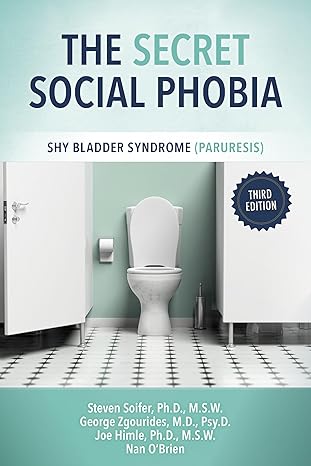Literature References
Abramovici,I.,and M. Assael. 1981. Psychogenic retention of urine. Psychiatria Clinica 14:196-204.
Allen,T.D. 1972. Psychogenic urinary retention. Southern Medical Journal 65:302-304.
American Psychiatric Association. 1994. The Diagnostic and Statistical Manual of Mental Disorders – Fourth Edition. Washington, D.C. :Author.
Anderson,L. T. 1977. Desensitization in vivo for men unable to urinate in a public facility. Journal of Behavior Therapy and Experimental Psychology, 8:105-106.
Anonymous. 1976, June 26. Urinary retention in women. British Medical Journal, 1554.
Ascher, L. M. 1979. Paradoxical intention in the treatment of urinary retention. Behaviour Research and Therapy 17:267-270.
Barnard, G., C. Flescher, and R. Stinbrook. 1966. The treatment of urinary retention by aversive stimulus cessation and assertive training. Behaviour Research and Therapy 4:231-236.
Barrett, D. M. 1976. Psychogenic urinary retention in women. Mayo Clinic Proceedings 51:351-356.
Bassi, P., F. Zattoni, F. Aragona, F., M. Dal Bianco, A. Calabro, and W. Artibani. 1988. Psychogenic urinary retention of urine in women: Diagnostic and therapeutic problems. Journal of Urology Paris, 94:159-162.
Bird, J. R. 1980. Psychogenic urinary retention. Psychotherapy and Psychosomatics 34:45-51.
Bohn, P., and Sternbach, H. 1997. Current knowledge and research directions in the treatment of paruresis. Depression and Anxiety 5:41-42.
Bosio, M., S. Mazzucchelli and S. Sandri. 1996. Psychogenic urinary retention in childhood: A severe case treated by an integrated global approach. Minerva Pediatrician 48:117-120.
Bourne, E.J. 1998. Healing fear: New approaches to overcoming anxiety. Oakland: New Harbinger.
Bourne, E. J. 1995. The anxiety and phobia workbook (2nd edition). Oakland: New Harbinger.
Braasch, W. F. and G. J. Thompson. 1935. Treatment of the atonic bladder. Surgery, Gynecology and Obstetrics 61:379-384.
Caffaratti, J., S.Perez-Rodriguez, J.M. Garat and L. Farre. 1993. Acute urinary retention of psychogenic cause in a girl. Actas Urology Espanola, 17:367-370.
Chapman, A. H. 1959. Psychogenic urinary retention in women: Report of a case. Psychosomatic Medicine, 21: 119-122.
Christmas, T.J., J.G. Noble, G.M. Watson, and R.T. Turner-Warwick. 1991. Use of biofeedback in treatment of psychogenic voiding dysfunction. Urology 37:43-45.
Cooper, A. J. 1965. Conditioning therapy in hysterical retention of urine. British Journal of Psychiatry 111: 575-577.
Davis, M, E.R. Eshelman, and M. McKay. 1995. The Relaxation and Stress Reduction Workbook (4th Edition). Oakland, CA: New Harbinger Publications.
Davison, G. C. 1968. Elimination of a sadistic fantasy by a client-controlled counter-conditioning technique: A case study. Journal of Abnormal Psychology 73:84-90
Elitzur, Baruch. (2000). Psychological treatment for bashful bladder. Harefuah, (12), 1021-23, 1087.
Elliott, R. 1967. A case of inhibition of micturition: unsystematic desensitization. Psychological Record 17:525-530.
Ellis, A. 1962. Reason and Emotion in Psychotherapy. New York: Lyle Stuart.
Emmett, J. L., S.P.R. Hutchins, and J.R. McDonald. 1950. The treatment of urinary retention in women by transurethral resection. Journal of Urology 63:1031-1042.
Fezler, W. 1989. Creative imagery: How to visualize in all five senses. New York: Simon and Schuster.
Fukui, J., F. Nukui, K. Kontani, M. Nagata, J. Kurokawa, M. Katsuta, T. Sugimura, S. Okamoto, and H. Komatsu. 1999. Psychogenic lower urinary tract dysfunction in women: Pathophysiological investigation for psychogenic frequency-urgency syndrome and psychogenic urinary retention. Nippon Hinykika Gakkai Zasshi, 90:769-778.
Glasgow, R. E. 1975. In vivo exposure in the treatment of urinary retention. Behavior Therapy 6:701-702.
Goodwin, R. J., M.J. Swinn, and C.J. Fowler. 1998. The neurophysiology of urinary retention in young women and its treatment by neuromodulation. World Journal of Urology 16:305-307.
Gruber, D. L, and D.R. Shupe. 1982. Personality correlates of urinary hesitancy paruresis and body shyness in male college students. Journal of College Student Personnel 23:308-313.
Hammelstein, P., Jantsch, B., Barnett, W. (2003). Ein bisher vernachlassigtes psychotherapeutishces Prolem. Psychotherapeut 48: 260-263.
Hammelstein, P. , Peitrowsky, R., Merbach, M. & Braehler, E. (2002). Psychogenic urinary retention (“Paruresis”): Diagnosis and epidemiology in a representative male sample.
Hammelstein, P. & Soifer, S. (2005). Is “shy bladder syndrome” (paruresis) correctly classified as social phobia? Journal of Anxiety Disorders. In press.
Hatterer, J. A., J.M. Gorman, A.J. Fyer, R. Campeas, F.R. Schneier, E. Hollander, L.A. Papp, and M.R. Liebowitz. 1990. Clinical and research reports: Pharmacotherapy for four men with paruresis. American Journal of Psychiatry 147:109-111.
Horan, J. L. 1997. The Porcelain God: A Social History of the Toilet. Secaucus: Citadel Press.
Jacob, R. G., and D.J. Moore. 1984. Paradoxical interventions in behavioral medicine. Journal of Behavior Therapy and Experimental Psychiatry 15:205-213.
Jaspers, J. P. 1998. Cognitive-behavioral therapy for paruresis: A case report. Psychological Reports 83:187-196.
Johnson, S.L. 1997. Therapist’s Guide to Clinical Intervention. San Diego, CA: Academic Press.
Kawabe, K., and T. Niijima. 1987. Use of an alpha1-blocker, YM-12617, in micturition difficulty. Urology International 42:280-284.
Kessler, R.C., M.B. Stein, and P. Berglund. 1997. Social phobia subtypes in the National Co-morbidity study. Boston: Department of Health Care Policy, Harvard Medical School.
Khan, A. U. 1971. Psychogenic urinary retention in a boy. The Journal of Urology 106:432-434.
Kira, A. Privacy in the bathroom. 1970. In Environmental Psychology: Man and his Physical Setting, edited by H. M. Proshansky, W. H. Ittelson, and L. B. Rivlin. New York: Holt, Rinehart & Winston.
Kira, A. 1976. The Bathroom. New York: Viking.
Kitami, K., M. Masuda, K. Chiba, and H. Kumagai. 1989. Psychogenic urinary retention: Report of two cases. Hinyokika Kiyo 35:509-512.
Knowles, F. W. 1964. Hypnotherapy in chronic hysterical urinary retention: Report of a case. New Zealand Medical Journal 63:38-40.
Knox, S.J. 1960. Psychogenic urinary retention after parturition, resulting in hydronephrosis. British Medical Journal 2:1422-1424.
Kroll, P., M. Marynski, and A. Jankowski. 1998. The role of psychogenic factors as a cause of urinary retention in a patient with lazy bladder syndrome. Wiad Lek, 51: 102-5.
Kurtz, L.F. 1997. Self-help and Support Groups: A Handbook for Practitioners. Thousand Oaks: Sage.
Labbate, L. A. 1997. Paruresis and urine drug testing. Depression and Anxiety 4:249-252.
Lamontagne, Y., and I.M. Marks. 1973. Psychogenic urinary retention: Treatment by prolonged exposure. Behavior Therapy 4:581-585.
Larson, J. W., W.M. Swenson, D.C. Utz, and R.M. Steinhilber. 1963. Psychogenic urinary retention in women. Journal of the American Medical Association 184:697-700.
Macaulay, A. J., R.S. Stern, D.M. Holmes, and S. Stanton. 1987. Micturition and the mind: Psychological factors in the aetiology and treatment of urinary symptoms in women. British Medical Journal 294:540-543.
Malouff, J. M., and R.I. Lanyon. 1985. Avoidant paruresis: An exploratory study. Behavior Modification 9:225-234.
Margolis, G. J. 1965. A review of literature on psychogenic urinary retention. The Journal of Urology 94:257-258.
Markway, B. G., C.N. Carmin, C.A. Pollard, and T. Flynn. 1992. Dying of Embarrassment: Help for Social Anxiety and Phobia. Oakland, CA: New Harbinger.
Marshall, J.R. 1994. Social phobia: From shyness to stage fright. New York: Basic Books.
McCracken, L.M., and K.T. Larkin. 1991. Treatment of paruresis with in vivo desensitization: A case report. Journal of Behavior Therapy and Experimental Psychology 22:57-62.
Menninger, K.A. 1941. Some observations on the psychological factors in urination and genito-urninary afflictions. Psychoanalytic Review 28:117-129.
Men’s Health. 1997, October. Malegrams: Mind over bladder. New York: Author.
Middlemist, R. D., E.S. Knowles, and C.F. Matter. 1976. Personal space invasions in the lavatory: Suggestive evidence of arousal. Journal of Personality and Social Psychology 33:541-546.
Montague, D. K., and L.R. Jones. 1979. Psychogenic urinary retention. Urology 13:30-35.
Mozdzierz, G. J. 1985. The use of hypnosis and paradox in the treatment of a case of chronic urinary retention/”bashful bladder.” American Journal of Clinical Hypnosis 28:43-47.
National Institute of Mental Health. 1994. Anxiety Disorders. Washington, D.C.: Author.
Newman, E. 1997. Going Abroad. St. Paul: Marlor Press.
Nicolau, R., J. Toro and C.P. Prado. 1991. Behavioral treatment of a case of psychogenic urinary retention. Journal of Behavior Therapy and Experimental Psychology 22:63-68.
Norden, C. W., and E.A. Friedman. 1961. Psychogenic urinary retention: Report of two cases. The New England Journal of Medicine 264:1096-1097.
Palmtag, H., and G. Riedasch. 1980. Psychogenic voiding patterns. Urologia Internationalis 35:321-327.
Pathak, B. 1995. History of Toilets, presented at the International Symposium on Public Toilets, Hong Kong, May 25-27. (9/11/99).
Pedersen, V. C. 923. Retention neurosis of the bladder, secondary to postoperative catheterization. New York Medical Journal and Medical Record 118:269-272.
Ray, I. and J. Morphy. 1975. Metronome conditioned relaxation and urinary retention. Canadian Psychiatric Association Journal 20:139-141.
Rees, B. and D. Leach. 1975. The social inhibition of micturition paruresis: Sex similarities and differences. Journal of The American College Health Association: 23:203-205.
Ritch, C. O. 1946. Urologic neurosis and psychoses. Illinois Medical Journal 89:131-132.
Rogers, G. M. (2003). Treatment of paruresis in the context of benign prostatic hyperplasia: A case report. Cognitive and Behavioral Practice, (10): 168-177.
Rosario, D.J., C.R. Chapple, P.R. Tophill, and H.H. Woo. 2000. Urodynamic assessment of the bashful bladder. Journal of Urology 163:215-220.
Scott, F.B., E.M. Quesada, and D. Cardus. 1964. Studies on the dynamics of micturition: Observations of healthy men. Journal of Urology 92:455-463.
Seif, B. 1982. Hypnosis in a man with fear of voiding in public facilities. The American Journal of Clinical Hypnosis 24:288-289.
Silverman, P. 1980. Mutual Help Groups: Organization and Development. Beverly Hills: Sage.
Soifer, S. , Himle, J., & Walsh, K. (2005?). Paruresis: Shy bladder syndrome – the last to be discovered social phobia? (in process).
Stams, U.K., C.H. Martin, and T.G. Tan. 1982. Psychogenic urinary retention in eight-year-old boy. Urology 20:83-85.
Stanton, S. 1976, August 14. Urinary retention in women. British Medical Journal: 420-421.
Stein, M.B.,., Torgrud, L. J., Walker, J.R. (2000). Social phobia symptoms, subtypes, and severity: Findings from a community survey. Archives of General Psychiatry, (57): 1046-1052.
Straub, L.R., H.S. Ripley and S. Wolf. 1949. Disturbances of bladder function associated with emotional states. 141:1139-1143.
Tanagho, E.A., and E.R. Miller. 1970. Initiation of voiding. British Journal of Urology 42:175-183.
Thyer, B.A., and G.C. Curtis. 1984. Furosemide as an adjunct to exposure therapy of psychogenic urinary retention. Perceptual and Motor Skills 59:114.
Van der Linden, E.F., and P.L. Venema. 1998. Acute urinary retention in women. Ned Tijdschr Geneeskd 142:1603-1606.
Vythinlingum, B., Stein, D. J., & Soifer, S. (2002). Is “shy bladder syndrome” a subtype of social anxiety disorder? A survey of people with paruresis. Depression and Anxiety, (16): 84-87.
Wahl, C.W., and J.S. Golden. 1963. Psychogenic urinary retention: Report of 6 cases. Psychosomatic Medicine, 25:543-555.
Watson, T. S. & Freeland, J. T. (2000). Treating paruresis using respondent conditioning. Journal of Behavior Therapy, (31): 155-162.
Weissberg, J.H., and A.N. Levay. 1979. Difficulty in urinating in public restrooms. Patient Care, April.
Williams, G.E., and A.M. Johnson. 1956. Recurrent urinary retention due to emotional factors: Report of a case. Psychosomatic Medicine 28:77-80.
Williams, G.W. and E.T. Degenhardt. 1954. Paruresis: A survey of a disorder of micturition. The Journal of General Psychology 51:19-29.
Wilson, G.T. 1973. Case reports and studies: Innovations in the modification of phobic behaviors in two clinical cases. Behavior Therapy 4:426-430.
Winsbury-White, H.P. 1936. Two cases of retention of urine in women. The Lancet, May 2, 1008-1009.
Wobus, R.E. 1922. Notes on the psychic influence on bladder disturbances in women. Journal of the Missouri State Medical Association 19:111-113.
Zgourides, G.D. 1987. Paruresis: Overview and implications for treatment. Psychological Reports 60:1171-1176.
Zgourides, G.D. 1988. Bethanechol chloride as a suggested adjunct to prolonged in vivo exposure therapy in the treatment of paruresis. Perceptual and Motor Skills 66:319-322.
Zgourides, G. 1991. Atenolol treatment of paruresis. Psychological Reports 68:766.
Zgourides, G. D. 1996. Management of paruresis by urinary self-catheterization. Anxiety Disorder Practice Journal 2:197-198.
Zgourides, G. D. and R. Warren. 1990. Propranolol treatment of paruresis psychogenic urinary retention: A brief case report. Perceptual and Motor Skills 71: 885-886.
Zgourides, G.D., R. Warren, and M. Englert. 1990. Use of a portable radio-headset as an adjunct to exposure therapy in treating paruresis. Phobia Practice and Research Journal 3:43-44.
QUICK LINKS
INTERNATIONAL PARURESIS ASSOCIATION
P.O. Box 21237
Catonsville, MD 21228
You Are Not Alone.
There Is Help For You!
Shy Bladder, Bashful Bladder, Pee Shy
IPA OFFICE HOURS
Monday - Friday
10:00am - 6:00pm (ET)
844-I-CANT-PEE (422-6873)
US/Canada
443-315-5250 Office
Email: getinfo@paruresis.org
This website is NOT a substitute for medical or legal advice and does not constitute the practice of law, medicine, psychiatry, clinical psychology, clinical social work, or any other mental health profession. If you are having trouble urinating, you should always contact a physician since difficulty with voiding can be a symptom of a serious medical condition. We are a group of professional people and people who have suffered with paruresis. We have assembled a board and a board of advisors to help people cope with urinary dysfunction that has a psychological or social origin. On this website, we are NOT practicing medicine, psychiatry, clinical psychology, clinical social work or any other mental health profession. You should have your doctor evaluate your condition before diagnosing yourself, and seek the appropriate necessary mental health counseling if warranted. IPA, Inc. disclaims any and all legal liability whatsoever. Use of the term “member” or “membership” refers to donors above $100 each July 1 to June 30 period and does not convey any legal or ownership rights in IPA.




